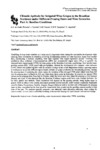Use este identificador para citar ou linkar para este item:
http://www.alice.cnptia.embrapa.br/alice/handle/doc/945900Registro completo de metadados
| Campo DC | Valor | Idioma |
|---|---|---|
| dc.contributor.author | TEIXEIRA, A. H. de C. | pt_BR |
| dc.contributor.author | TONIETTO, J. | pt_BR |
| dc.contributor.author | PEREIRA, G. E. | pt_BR |
| dc.contributor.author | TANGERINO, F. B. T. | pt_BR |
| dc.contributor.author | ANGELOTTI, F. | pt_BR |
| dc.date.accessioned | 2013-01-25T23:04:00Z | - |
| dc.date.available | 2013-01-25T23:04:00Z | - |
| dc.date.created | 2013-01-21 | pt_BR |
| dc.date.issued | 2011 | pt_BR |
| dc.identifier.citation | In: INTERNATIONAL SYMPOSIUM ON TROPICAL WINE, 3., 2011, Chiang Mai, Thailand. Proceedings... Chiang Mai: Rajamangala University of Technology Lanna Doi Saket, 2011. | pt_BR |
| dc.identifier.uri | http://www.alice.cnptia.embrapa.br/alice/handle/doc/945900 | pt_BR |
| dc.description | ModeIling of crop water variables on a large scale is important when aiming for sustainable development while ensuring water availability in situations involving alI depending sectors on water resources. Long term weather data, representing a baseline condition, were used together with simple regression models involving crop coefficient (Kc), reference evapotranspiration (ETO) and accumulated degree days (DDac) to quantify the vineyard water requirements (VWR) for wine grapes in the Brazilian Northeast, considering a four months mean growing season (GS). VWR joined with precipitation, aIlowed the development of a vineyard water indicator (VWI), which was applied together with the monthly average values of air temperature during a growing season to characterize areas with different agro-climatic aptitude for grape production for winemaking process, varying the pruning dates. Considering the whole region, the variation of the averaged VWR pixel values were from 300 mm for pruning dates in March to 410 mm, when these dates occur in September. ln general, the highest VWR values are for pruning dates from July to October, while the lower rates were when the pruning is done between January and April. It was observed that the Brazilian Northeast region could have some thermallimitation for the wine quality and stability. These limitations wiIl depend on the pruning periods, being higher sugar in grapes, while in wines, lower acidity and higher potential alcohol and pH, under warmer conditions. Highlights were for Bahia, Pemambuco, Paraíba, Alagoas, Sergipe States as weIl as the west side of Maranhão for pruning dates in May, considered as the best areas for commercial wine production for growing seasons starting at this time of the year. The analyses spatiaIly presented, can subsidize water aIlocation criterions, when aiming for improvements on vine water availability avoiding environmental damage by rapid climate and land use change. | eng |
| dc.language.iso | eng | eng |
| dc.rights | openAccess | eng |
| dc.subject | Modelagem | pt_BR |
| dc.subject | Vinho tropical | pt_BR |
| dc.title | Climatic aptitude for irrigated wine grapes in the Brazilian Northeast under different prunning dates and time scenarios. Part A: baseline conditions. | pt_BR |
| dc.type | Resumo em anais e proceedings | pt_BR |
| dc.date.updated | 2013-01-25T23:04:00Z | pt_BR |
| dc.subject.thesagro | Água | pt_BR |
| dc.subject.thesagro | Clima | pt_BR |
| dc.subject.thesagro | Deficiência hídrica | pt_BR |
| dc.subject.thesagro | Disponibilidade de água | pt_BR |
| dc.subject.thesagro | Temperatura | pt_BR |
| dc.subject.thesagro | Uva | pt_BR |
| dc.subject.thesagro | Vinho | pt_BR |
| dc.subject.thesagro | Viticultura | pt_BR |
| dc.subject.nalthesaurus | Grapes | pt_BR |
| dc.subject.nalthesaurus | Water requirement | eng |
| dc.format.extent2 | p. 4. | pt_BR |
| riaa.ainfo.id | 945900 | pt_BR |
| riaa.ainfo.lastupdate | 2013-01-25 | pt_BR |
| dc.contributor.institution | ANTONIO HERIBERTO DE C TEIXEIRA, CPATSA | pt_BR |
| dc.contributor.institution | JORGE TONIETTO, CNPUV | eng |
| dc.contributor.institution | GIULIANO ELIAS PEREIRA, CNPUV | eng |
| dc.contributor.institution | F. B. T. TANGERINO, USP | eng |
| dc.contributor.institution | FRANCISLENE ANGELOTTI, CPATSA. | eng |
| Aparece nas coleções: | Resumo em anais de congresso (CPATSA)  | |
Arquivos associados a este item:
| Arquivo | Descrição | Tamanho | Formato | |
|---|---|---|---|---|
| Angeloti.pdf | 59,61 kB | Adobe PDF |  Visualizar/Abrir |









